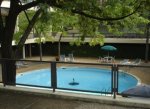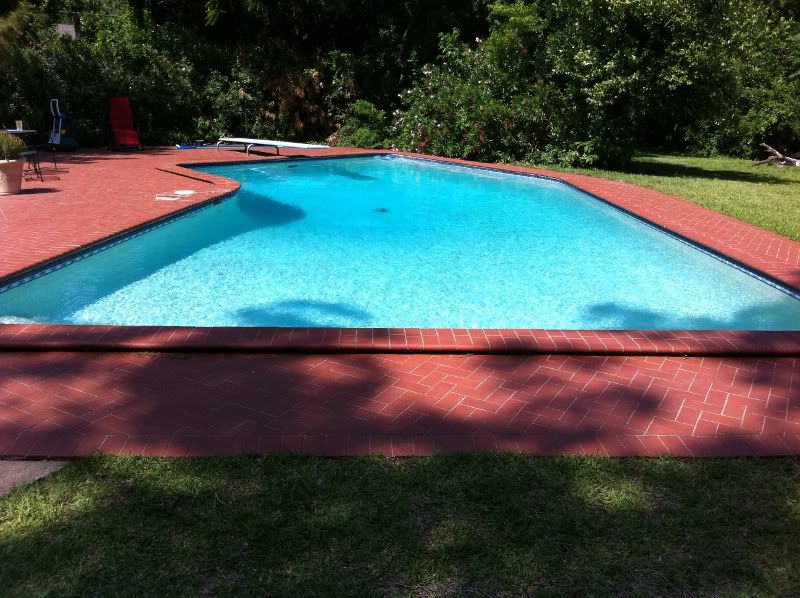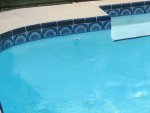...it was a little over 40 years ago, and I was a lifeguard at community pools and apartment complexes in my hometown during my college summers.
Some of the pools were large, some were immense (acres of water), and a round one even had tile-line arcing jets that met at a central fountain atop a post that rose from the pool floor (a dangerous obstacle to swimmers) and was colorfully illuminated as it shot a plume of water about 8 stories into the air. Wet, wild and wacky.
to swimmers) and was colorfully illuminated as it shot a plume of water about 8 stories into the air. Wet, wild and wacky.
Swimming forward about 35 years, buying a home with my first residential pool several years ago, becoming a member of TFP, and reading so many posts here discussing Pool Store Products recently got me thinking back....
40 years ago, in most of those pool equipment rooms there was:
A huge sand filter or two.
A 200-500 gallon vat of chlorine, thick and viscous, with a tube connecting it to a
Timed chlorinator pump, and an outgoing tube plumbed into the return water pipe(s).
Jugs of Acid to lower pH.
Covered bin of Soda Ash to raise pH.
A pool brush.
A vacuum hose, head and pole handle.
A skimmer net.
Buckets, cleaning rags, and towels.
A test kit and a first aid kit were kept in the pool office.
And these rooms would be inspected by the health department.
No algaecide, no clarifier, no floc. No fancy products. None.
We were essentially using the BBB Method, only without the Borax and Baking Soda.
That was how I was taught by professionals to maintain pools efficiently and inexpensively in 1971.
With additional knowledge about Borax and Baking Soda these days, it's how I maintain our pool now.
So, Thanks to TFP for keeping it simple.
I don't mess with success, and I don't waste our $$$ on fancy products.
And our pool sparkles.
BTW, when we refurbished the pool 7 1/2 years ago, we received some Products. Those containers are still gathered in a bucket, in our pool box, because I can't see putting them into a landfill, let alone into our pool!
Some of the pools were large, some were immense (acres of water), and a round one even had tile-line arcing jets that met at a central fountain atop a post that rose from the pool floor (a dangerous obstacle
 to swimmers) and was colorfully illuminated as it shot a plume of water about 8 stories into the air. Wet, wild and wacky.
to swimmers) and was colorfully illuminated as it shot a plume of water about 8 stories into the air. Wet, wild and wacky. Swimming forward about 35 years, buying a home with my first residential pool several years ago, becoming a member of TFP, and reading so many posts here discussing Pool Store Products recently got me thinking back....
40 years ago, in most of those pool equipment rooms there was:
A huge sand filter or two.
A 200-500 gallon vat of chlorine, thick and viscous, with a tube connecting it to a
Timed chlorinator pump, and an outgoing tube plumbed into the return water pipe(s).
Jugs of Acid to lower pH.
Covered bin of Soda Ash to raise pH.
A pool brush.
A vacuum hose, head and pole handle.
A skimmer net.
Buckets, cleaning rags, and towels.
A test kit and a first aid kit were kept in the pool office.
And these rooms would be inspected by the health department.
No algaecide, no clarifier, no floc. No fancy products. None.
We were essentially using the BBB Method, only without the Borax and Baking Soda.
That was how I was taught by professionals to maintain pools efficiently and inexpensively in 1971.
With additional knowledge about Borax and Baking Soda these days, it's how I maintain our pool now.
So, Thanks to TFP for keeping it simple.

I don't mess with success, and I don't waste our $$$ on fancy products.
And our pool sparkles.
BTW, when we refurbished the pool 7 1/2 years ago, we received some Products. Those containers are still gathered in a bucket, in our pool box, because I can't see putting them into a landfill, let alone into our pool!












